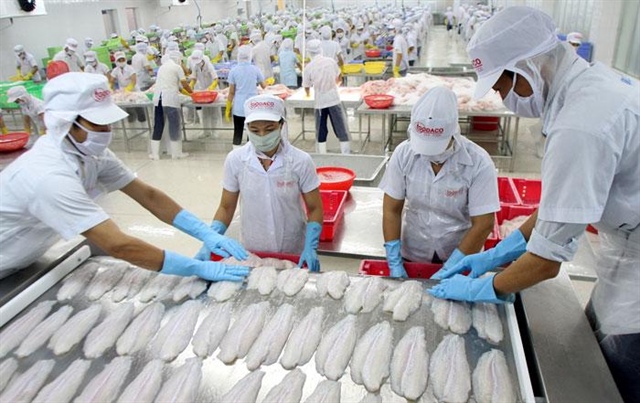Vietnam's seafood exports surge 51% to US$1.5 billion in 2 months
Vietnam's seafood exports surge 51% to US$1.5 billion in 2 months
Seafood currently makes up 18% of Vietnam’s total exports of agro-forestry-fishery products, with the US being the largest buyer for 23% of the total market share.
During the first two months of 2021, Vietnam’s seafood exports surged by 51% year-on-year to US$1.5 billion, according to the Vietnam Association of Seafood Exporters and Producers (VASEP).

Processing frozen catfish for export at Go Dang Company, My Tho Industrial Park, Tien Giang Province. Photo: Hung Viet |
Among the lot, catfish and shrimps posted the highest export growth in February, with the former accumulating a revenue of $384 million, or an increase of 93%, and the latter earning $550 million, up 46%.
Other products also witnessed a hike in export earnings during the two months, including tuna of $156 million, up 83%, squid and octopus of $97 million, up 45%.
In the US, frozen seafood has been preferred compared to fresh products as consumers are focusing more on processed food which has greater convenience and longer expiration dates.
This resulted in a sharp rise of 85% in Vietnam’s seafood exports to the US in February to $146 million.
Meanwhile, Vietnam’s exports of seafood to Japan also increased by 15% to $209 million in February, and China by 91% to $168 million.
VASEP pointed out that strict anti-Covid-19 measures from China are not the main challenge for local traders, but called for companies to step up efforts in the sterilization process, especially during the loading and unloading to avoid delay in customs clearance.
Seafood currently makes up 18% of Vietnam’s total exports of agro-forestry-fishery products, with the US being the largest buyer, making up 23% of the country’s seafood shipments.
Impacts from Russia-Ukraine conflict
For the time ahead, VASEP expected global demand for seafood would continue to rise, but the ongoing Russia-Ukraine conflict may slow down the trend in the short term with rising operational costs and subsequently declining revenue.
This is particularly true for the global tuna market. As of late 2021, Russia and Ukraine were among the top 20 largest importers of Vietnamese tuna in terms of revenue.
Russia is currently Vietnam’s 13th largest tuna market with an export turnover in the past 10 years rising from $364,000 in 2012 to $14 million in 2021 or an increase of 39-fold and 2% of Vietnam’s total tuna exports.
Such a trend has been on the rise despite the pandemic impacts, as the turnover grew by 58% against 2020 and higher than in the pre-Covid-19 period in 2019.
Meanwhile, Ukraine is Vietnam’s 19th largest tuna market with revenue-raising from $115,000 in 2012 to $6.8 million in 2021, or 1% of the total turnover from this product.
Russia and Ukraine are also the major suppliers of sunflower oil to the global market, including Vietnam, so the conflict would no doubt impact the processed tuna products and the industry overall, VASEP said.
As of present, the fact that prices of vegetable oils have risen to an all-time high in January coupled with skyrocketing oil prices have also led to higher costs in tuna fishing activities.
“Vietnam’s exports of tuna may slow down as a result in the coming months,” VASEP said.





















